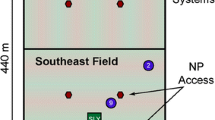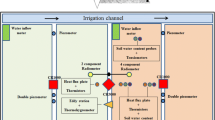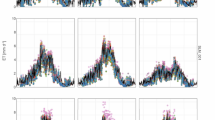Abstract
Eddy covariance (EC) systems are being used to assess the accuracy of remote sensing methods in mapping surface sensible and latent heat fluxes and evapotranspiration (ET) from local to regional scales, and in crop coefficient development. Therefore, the objective was to evaluate the accuracy of EC systems in measuring sensible heat (H) and latent heat (LE) fluxes. For this purpose, two EC systems were installed near large monolithic weighing lysimeters, on irrigated cotton fields in the Texas High Plains, during the months of June and July 2008. Sensible and latent heat fluxes were underestimated with an average error of about 30%. Most of the errors were from nocturnal measurements. Energy balance (EB) closure was 73.2–78.0% for daytime fluxes. Thus, daylight fluxes were adjusted for lack of EB closure using the Bowen ratio/preservation of energy principle, which improved the resulting EC heat flux agreement with lysimetric values. Further adjustments to EC-based ET included nighttime ET (composite) incorporation, and the use of ‘heat flux source area’ (footprint) functions to compensate ET when the footprint expanded beyond the crop field boundary. As a result, ET values remarkably matched lysimetric ET values, with a ‘mean bias error ± root mean square error’ of −0.03 ± 0.5 mm day−1 (or −0.6 ± 10.2%).









Similar content being viewed by others
References
Baldocchi D (1994) A comparative study of mass and energy exchange over a closed C3 (wheat) and an open C4 (corn) canopy: I. The partitioning of available energy into latent and sensible heat exchange. Agric For Meteorol 67:191–220
Birks HJB, Line JM, Juggins S, Stevenson AC, ter Braak CJF (1990) Diatoms and pH reconstruction. Philos Trans Roy Soc Lond Ser B 327:263–278
Boegh E, Thorsen M, Butts MB, Hansen S, Christiansen JS, Abrahamsen P, Hasager CB, Jensen NO, van der Keur P, Refsgaard JC, Schelde K, Soegaard H, Thomsen A (2004) Incorporating remote sensing data in physically based distributed agro-hydrological modeling. J Hydrol 287(1–4):279–299
Burba GG, Anderson DJ (2007) Introduction to the eddy covariance method: General guidelines and conventional workflow. LI-COR Biosciences, http://www.licor.com, 141 pp (accessed 10 April 2008)
Burman RD, Wright JL, Jensen ME (1975) Changes in climate and estimated evaporation across a large irrigated area in Idaho. Trans ASAE 18(6):1089–1093
Campbell GS, Norman JM (1998) An introduction to environmental biophysics, 2nd edn. Springer, New York, p 286
Chávez JL, Neale CMU (2003) Airborne remote sensing of evapotranspiration over riparian vegetation in the middle Rio Grande river. Report to the US Bureau of Reclamation
Chávez JL, Neale CMU, Hipps LE, Prueger JH, Kustas WP (2005) Comparing aircraft-based remotely sensed energy balance fluxes with eddy covariance tower data using heat flux source area functions. J Hydromet AMS 6(6):923–940. doi:10.1175/JHM467.1
Chávez JL, Gowda PH, Howell TA, Copeland KS (2007) Evaluating three evapotranspiration mapping algorithms with lysimetric data in the semi-arid Texas High Plains. In: Proceedings of the 28th annual international irrigation show. Irrigation Association CD-ROM, San Diego, 9–11 Dec. 2007, pp 268–283,
Colaizzi PD (2008) Personal communication. See http://www.cprl.ars.usda.gov/Wetting%20Front/WF_Vol10-No1.pdf, pp 12–17, accessed on 4 September 2008
Davenport DC, Hudson JP (1967) Changes in evaporation rates along a 17-km transect in the Sudan Gezira. Agric Meteorol 4:339–352
Field RT, Heiser M, Strebel DE (1994) Measurements of surface fluxes. The FIFE Information System. 9 April 1994. Available at: http://www.esm.versar.com/FIFE/FIFEhome.htm http://www.esm.versar.com/FIFE/Summary/Sur_flux.htm. Accessed 10 September 2004
Fitzjarrald DR, Moore KE (1994) Growing season boundary layer climate and surface exchange in a subartic lichen woodland. J Geophys Res 99(D1):1899–1917
Foken T (2006) 50 Years of the Monin–Obukhov similarity theory. Boundary Layer Meteorol 119(3):431–447
Fritschen LJ, Qian P, Kanemasu ET, Nie D, Smith EA, Steward JB, Verma SB, Wesely ML (1992) Comparisons of surface flux measurement systems used in FIFE 1989. J Geophys Res 97(d17):18697–18713
Gash JHC (1986) A note on estimating the effect of a limited fetch on micrometeorological evaporation measurements. Boundary Layer Meterol 35:409–413
Hipps L (2003) Land–atmosphere interactions. Class notes and personal communication. Utah State University, PSB Department, Logan
Hipps L, Kustas WP (2001) Patterns and organization in evaporation. In: Grayson R, Bloschl G (eds) Spatial patterns in catchment hydrology: observations and modelling, Cambridge University Press, UK, pp 105–122. ISBN 0-521-63316-8
Holifield CD, Emmerich WE, Moran MS, Hernandez M, Scott RL, Bryant RB, King DM, Verdugo CL (2008) A remote sensing approach for estimating distributed daily net carbon dioxide flux in semiarid grasslands. Water Resour Res 44:W05S17. doi:10.1029/2006/WR005699
Horst TW, Weil JC (1992) Footprint estimation for scalar flux measurements in the atmospheric surface layer. Boundary Layer Meteorol 59:279–296
Horst TW, Weil JC (1994) How far is far enough? The Fetch requirement for micrometeorological measurement of surface fluxes. J Atmos Ocean Tech 11(4):1018–1025
Howell TA, Schneider AD, Dusek DA, Marek TH, Steiner JL (1995) Calibration and scale performance of Bushland weighing lysimeters. Trans ASAE 38:1019–1024
Kaharabata SK, Schuepp PH, Ogunjemiyo S, Shen S, Leclerc MY, Desjardins RL, MacPherson JI (1997) Footprint considerations in BOREAS. J Geophys Res 102(D24):29,113–29124
Kustas WP, Perry EM, Doraiswamy PC, Moran MS (1994) Using satellite remote sensing to extrapolate evapotranspiration estimates in time and space over a semiarid Rangeland basin. Remote Sens Environ 49(3):275–286
Kustas WP, Hatfield JL, Prueger JH (2005) The soil moisture-atmosphere coupling experiment (SMACEX): background, hydrometeorological conditions and preliminary findings. J Hydromet AMS 6:791–804
Leclerc MY, Thurtell GW (1990) Footprint prediction of scalar fluxes using a Markovian analysis. Boundary Layer Meteorol 52:247–258
Leuning R (2007) The correct form of the Webb, Pearman and Leuning equation for eddy fluxes of trace gases in steady and non-steady, horizontal homogeneous flow. Boundary Layer Meteorol 123:263–267
Mahrt L (1998) Flux sampling error for aircrafts and towers. J Atmos Oceanic Technol 15:416–429
Malek E, Bingham GE (1993) Comparison of the Bowen ratio-energy balance and the water balance methods for the measurement of evapotranspiration. J Hydrol 146:209–220
Marek TH, Schneider AD, Howell TA, Ebeling LL (1988) Design and installation of large weighing monolithic lysimeters. Trans ASAE 31:477–484
Mauder M, Foken T (2006) Impact of post-field data processing on eddy covariance flux estimates and energy balance closure. Meterologische Zeitschrift 15(6):597–609
Mecikalski JR, Diak GR, Anderson MC, Norman JM (1999) Estimating fluxes on continental scales using remotely sensed data in an atmospheric-land exchange model. J Appl Meteorol 38:1352–1369
Moore CJ (1986) Frequency response corrections for eddy correlation systems. Boundary Layer Meteorol 37:17–35
Mu Q, Heinsch FA, Zhao M, Running SW (2007) Development of a global evapotranspiration algorithm based on MODIS and global meteorological data. Remote Sens Environ 111(4):519–536
New LL (2005) Agri-Partner irrigation result demonstrations 2005. Texas Cooperative Extension Service, Texas A&M University. Available on line at: http://amarillo.tamu.edu/programs/agripartners/irrigation2005.htm
Oncley SP, Foken T, Vogt R, Bernhofer C, Liu H, Sorbjan Z, Pitacco A, Grantz D, Ribeiro L (2000) The EBEX 2000 field experiment. In: 14th Symposium on boundary layers and turbulence. American Meteorological Society, Boston, Aspen, pp 322–324
Santos C, Lorite IJ, Tasumi M, Allen RG, Fereres E (2008) Integrating satellite-based evapotranspiration with simulation models for irrigation management at the scheme level. Irrig Sci 26:277–288. doi:10.1007/s00271-007-0093-9
Schmid HP (1994) Source areas for scalars and scalar fluxes. Boundary Layer Meteorol 67:293–318
Shuttleworth WJ (2007) Putting the “vap” into evaporation. Hydrol Earth Syst Sci 11(1):210–244
Suleiman A, Crago R (2004) Hourly and daytime ET from grassland using radiometric surface temperatures. Agron J 96:384–390
Todd RW, Evett SR, Howell TA (2000) The Bowen ratio-energy balance method for estimating latent heat flux of irrigated alfalfa evaluated in a semi-arid, advective environment. Agric For Meteorol 103(4):335–348
Tolk JA, Howell TA, Evett SR (2006a) Nighttime evapotranspiration from alfalfa and cotton in a semiarid climate. Agron J 98:730–736
Tolk JA, Evett SR, Howell TA (2006b) Advection influences on evapotranspiration of alfalfa in a semiarid climate”. Agron J 98:1646–1654
Twine TE, Kustas WP, Norman JM, Cook DR, Houser PR, Meyers TP, Prueger JH, Starks PJ, Wesely ML (2000) Correcting eddy-covariance flux underestimates over a grassland. Agric For Meteorol 103(3):229–317
Verma SB (1998) Flux footprint estimates affected by measurement height, surface roughness and thermal stability. http://snrsl.unl.edu/georgeb/footprint/fp-title.html. Accessed on 10 June 2004
Weaver HL (1990) Temperature and humidity flux-variance relations determined by one-dimensional eddy correlation. Boundary Layer Meteorol 53:77–91
Webb EK, Pearman GI, Leuning R (1980) Correlation of flux measurements for density effects due to heat and water vapour transfer. Quart J Roy Meteorol Soc 106:85–100
Wilson K, Goldstein A, Falge E, Aubinet M, Baldocchi D, Berbigier P, Bernhofer C, Ceulemans R, Dolman H, Field C, Grelle A, Ibrom A, Law BE, Kowalski A, Meyers T, Moncrieff J, Monson R, Oechel W, Tenhunen J, Valentini R, Verma S (2002) Energy balance closure at FLUXNET sites. Agric For Meteorol 113(2002):223–243
Acknowledgments
The authors are very thankful to the following individuals who provided technical assistance: Dr. Dario Canelon (University of Minneapolis), Dr. Sasha Ivans (Campbell Sci. Inc., Logan, Utah), Dr. John Prueger (USDA-ARS, Nat’l Soil Tilth Laboratory, Ames, IA), and to many Technicians from the USDA-ARS, Conservation and Production Research Laboratory, Bushland, TX. We also extend our appreciation to anonymous reviewers who helped improve the quality of this article.
Author information
Authors and Affiliations
Corresponding author
Additional information
Communicated by S. Ortega-Farias.
Appendix
Appendix
Conversion of daytime average LE fluxes into ET rate
where ET is evapotranspiration (mm day−1) converted from daytime average EC-measured LE (W m−2). λLE is the latent heat of vaporization (MJ kg−1), equal to (2.501–0.00236 Ta), being Ta in °C units, and ρw is water density (~1 Mg m−3). The 3,600 is a time conversion of s h−1; while the N is the number of bright sunshine hours per day. N is computed as follows:
where ωs is the sunset hour angle (radians), computed as:
where Γ is the location latitude (radians) and δ is the solar declination angle (radians).
where DOY is the day of the year and 366 is the number of days in a leap year. In our case, 2008 was a leap year; otherwise the number should be 365 for a regular year.
Rights and permissions
About this article
Cite this article
Chávez, J.L., Howell, T.A. & Copeland, K.S. Evaluating eddy covariance cotton ET measurements in an advective environment with large weighing lysimeters. Irrig Sci 28, 35–50 (2009). https://doi.org/10.1007/s00271-009-0179-7
Received:
Accepted:
Published:
Issue Date:
DOI: https://doi.org/10.1007/s00271-009-0179-7




